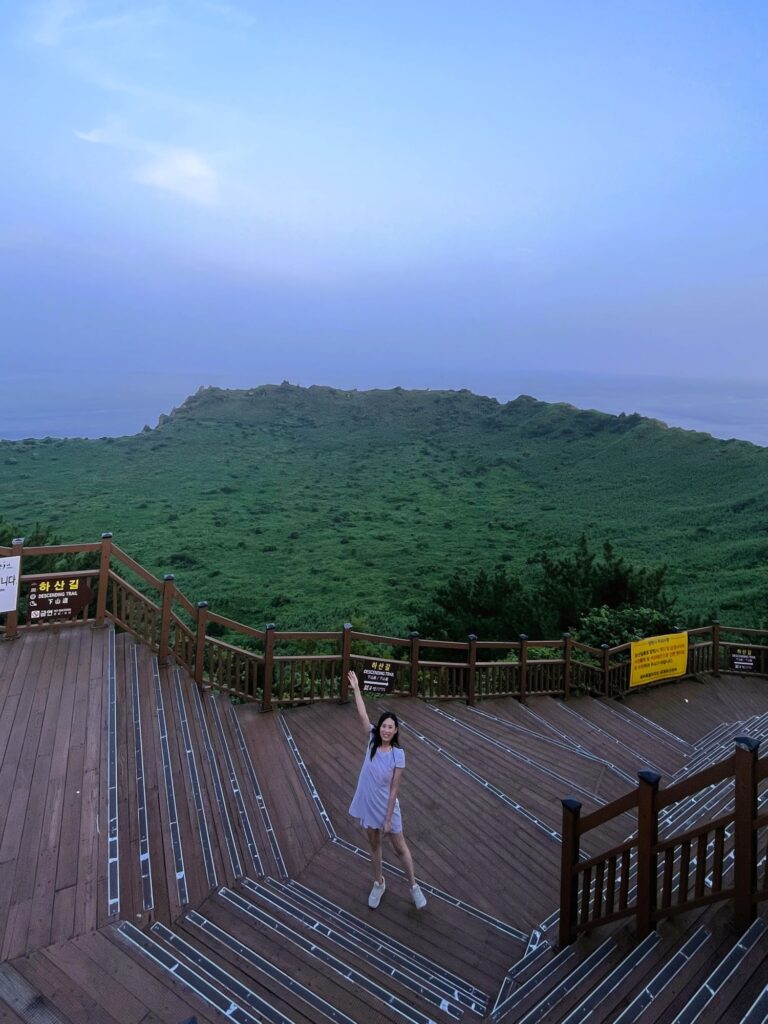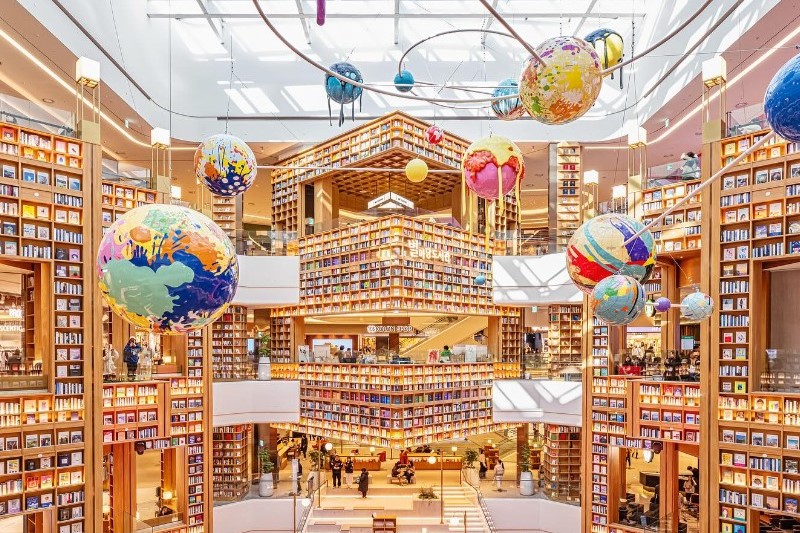9 Best Activities in Jeju
Activities in Jeju, What To Do, What To Plan
1. Must-Visit in Jeju-do
Sightseeing in Jeju is a must-do activity. Jeju Island possesses the most UNESCO Natural Heritage Sites. There are two cities: Jeju City and Seogwipo City. Aside from luxury hotel resorts and beaches, a big part of Jeju is raw. And each of those places will give you incredible immersive experiences.
Seongsan Ilchulbong
Seongsan Ilchulbong is a 5,000-year-old piece of nature with a panoramic view of Jeju. It is the perfect location for sunrise and sunset viewing. Come at 1:30 pm to see the exceptional diving Haenyeo performance (more information is below at 2. Hiking in Jeju).
📍 Access by Seongsan Ilchulbong Parking Lot (성산일출봉 주차장), free parking, access by bus (111, 112, 201, 295, 721-2, 721-3) | Address of Seongsan Ilchulbong: 137-1 Seongsan-ri, Seongsan-eup, Seogwipo-si, Jeju-do
Cheonjiyeon Waterfall
Located within walking distance of downtown Seogwipo, Cheonjiyeon is a legendary waterfall of Gods, meaning the pond of Heaven and the Earth. This waterfall is especially appreciated thanks to the lush nature and the night illuminations.
📍 Access by Cheonjiyeon parking (천지연폭포 주차장), free parking, access by bus (880) | Address of Cheonjiyeon Waterfall: 2 Namseongjung-ro, Cheonji-dong, Seogwipo-si, Jeju-do
Jeongbang Waterfall
Another famous waterfall is Jeongbang, the mysterious waterfall that falls directly into the sea. Legend says that a powerful dragon spirit created the waterfall. It is today one of the main tourist attractions of Jeju because it is possible to go down to be close to the water.
📍 Access by Jeongbang parking (정방폭포주차장), free parking, access by walking from bus 600 | Address of Jeongbang Waterfall: 278 Donghong-dong, Seogwipo-si, Jeju-do
Udo Island
Near Seongsan Ilchulbong is Udo Island, which you can join by taking the ferry. This part of Jeju is known for its peanut ice cream and cute renting vehicles. It is the perfect day trip destination with less crowded beaches. I much appreciated this destination and vlogged about it! Usually, tourists stay for half a day, but it is possible to stay overnight without running out of things to do.
📍 Access by ferry from the port of Seongsanpo Parking lot (성산포항 공영주차장), toll parking, access by walking from the bus 201, 211, 212, 295, 722 | Address of the ferry port to Udo: 130-19 Seongsandeungyong-ro, Seongsan-eup, Seogwipo-si, Jeju-do
Hyeopjae Beach
Located on the west side of Jeju-do is Hyeopjae Beach. It is the largest and most famous sand beach in Jeju, with Geumneung Beach next to it. The area is like a vacation town with everything needed: good restaurants, transportation, and kids-friendly.
📍 Access by car or bus 202, 784-1, 784-2 | Address of Hyeopjae Beach Free Parking: 2018 Geumneung-ri, Hallim-eup, Jeju-si, Jeju-do
The Manjanggul Cave, Ossuloc Tea Museum, Arte Museum, Jeju Love Land, and the Jeju Folk Village are other famous landmarks. I don’t think they are must-see places, especially if you lack time to visit the Island. But they are for sure very unique and fun!
Instead, if you have enough time in Jeju, I recommend visiting Hallim Park, hiking on Mt. Hallasan, or discovering fairytale-like Oreums.
2. Hiking in Jeju
Hiking activities in Jeju include easy walking trails, trails on hills, and famous trails on Mt. Hallasan (a future article will cover the subject entirely). The most-visited hiking area is Seongsan Ilchulbong, a UNESCO Natural Heritage Site.
Seongsan Ilchulbong trail (2 hours)
Among the hundreds of volcanic cones on Jeju Island called “Oreum” (오름), Seongsan Ilchulbong is unique because of its preserved nature, a no man’s land. It is also the best panoramic view of Seogwipo, Jeju-do, thanks to the observatory built on the peak.
The foothill is well-maintained and has facilities with a free parking lot. To access the trail up to the tuff cone of Seongsan costs 2,000 won (1,5 USD) per adult and 1,000 won (0,75 USD) per child.
The foothill itself is picture-worthy with its vast meadow and view of Seongsan’s rocks. Then, count about 30 minutes to arrive at the peak with a steep staircase. The easy access to the top, compared to other oreums, makes Seongsan the ideal oreum for tight schedules.
Visiting in winter, it is a must-do to see the sunrise there. The other name of Seongsan Ilchulbong is the Sunrise Peak. Many Koreans do that to celebrate the New Year. The rest of the year, it is the sunsets that are the main highlight. The closing time of the ticket booth is 6:30 pm from March to October and until 5 pm in November and December.
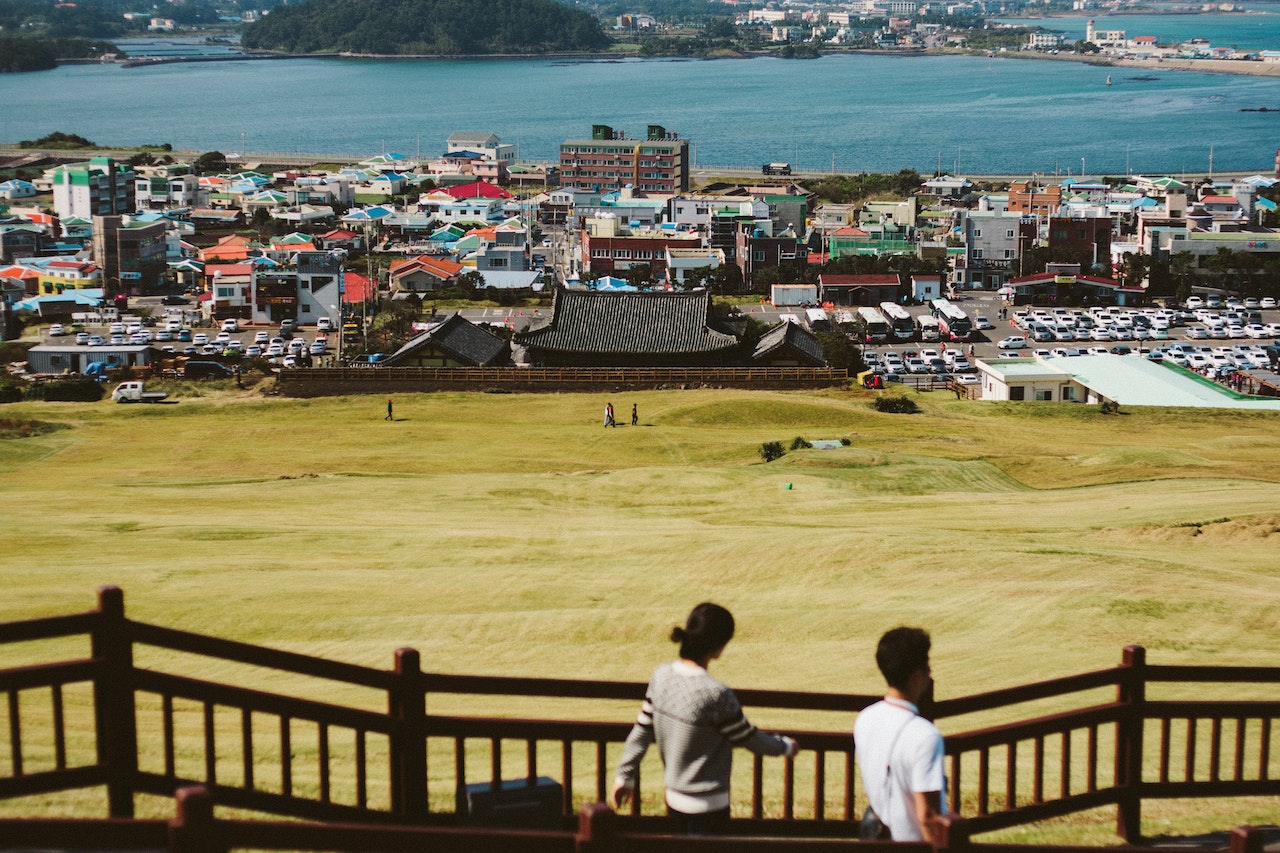
Mt. Hallasan, the highest peak in South Korea (5 to 8 hours)
This is the highest mountain in South Korea. It has a few trails passing by forests, steep rocky paths, and temples. Being the heart of Jeju-do, many tourists challenge themselves on their way to the peak.
The trails going up to the peak are regulated. Visitors are only allowed with a reservation. Visit their website visithalla.jeju.go.kr to make your reservation for the Seongpanak and Gwaneumsa trails. Also, make sure to check the weather and dress accordingly.
I recommend reading Erika’s blog post and taking the Seongpanak trail up with the Gwaneumsa trail down. To summarize, both are difficult. Seongpanak is faster, and Gwaneumsa is more scenic.
To access the trails, take the bus and not your car. The parking there is known to be full before sunrise. You can take buses number 281 and 181 (Seongpanak), and 281 and 475 (Gwaneumsa), more information are on the Jeju bus website.
3. Eat food specialties from Jeju
Korean Barbecue of Jeju Black Pork
Jeju has a unique pork breed called the Jeju Black Pork (제주흑돼지). It is cooked in a way to tastes chewier and smokier than normal Korean Pork Barbecue.
I highly recommend trying 2 restaurants located in Seogwipo: Ppolsaljib (뽈살집) and Black Pork BBQ (흑돼지 BBQ).
Ppolsaljib will give you the experience of trying black pork like a course menu, almost like an omakase experience. Both barbecues have only one menu so ordering is easy! The price depends on the number of people (costs around 15 USD per person).
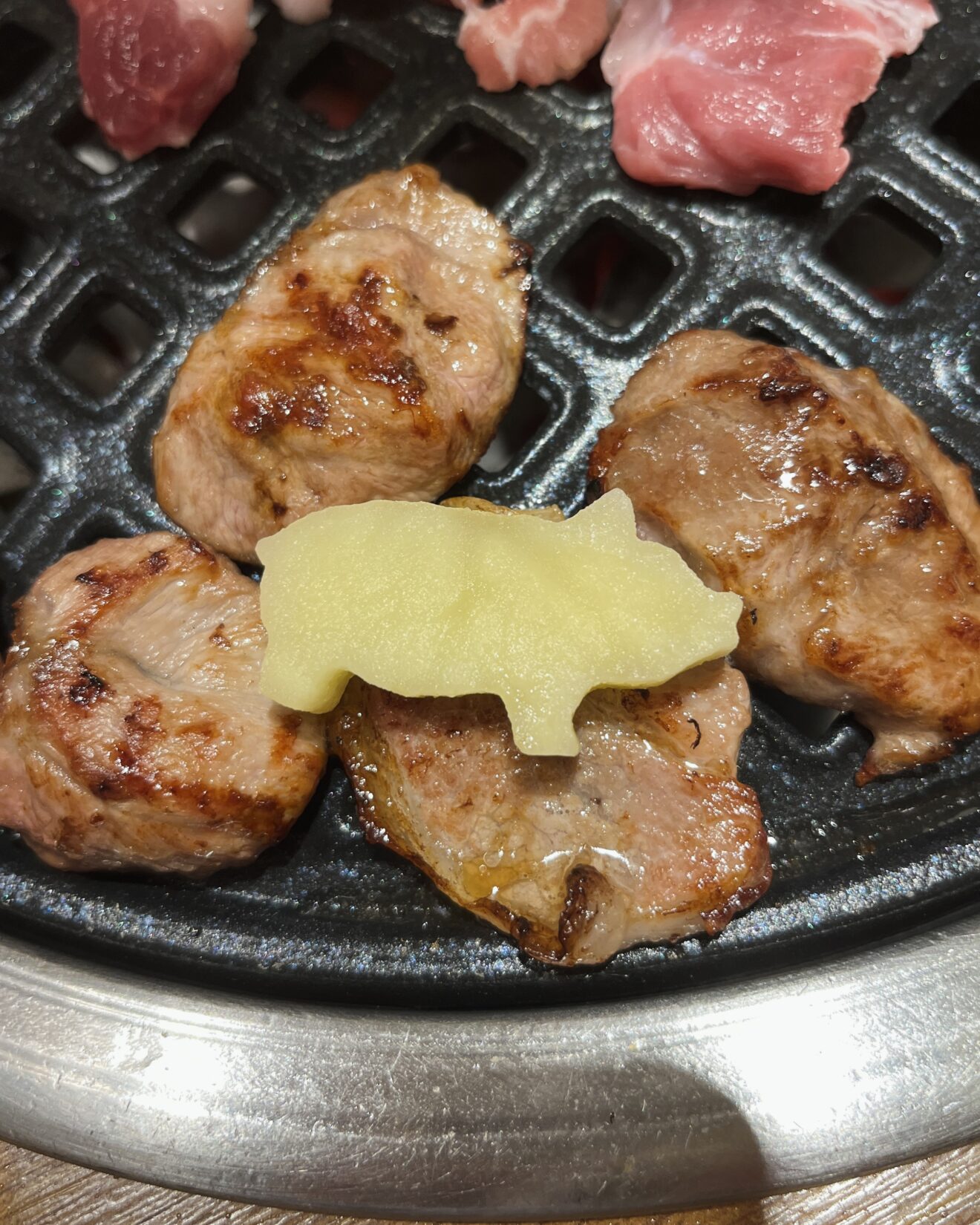

Abalone
South Korea loves seafood. Many cities have seafood as their food specialties. Jeju has many seafood restaurants, including raw fish, hairtail fish, and seafood noodles.
The authentic Jeju seafood specialties are seaweed, sea cucumber, octopus, and abalone due to be related to the legendary Haenyeo divers.
I recommend trying the abalone rice porridge and abalone pancake at Damda restaurant near Hyeopjae Beach.
Seogwipo Olle Market
It is the biggest food market on Jeju Island. You can buy souvenirs, seafood, tangerines, but also street food. The night market starts at 6 pm with even more trendy street foods. So, I would recommend going there by 5 pm.
You can watch my vlog to see what I ate and bought there!
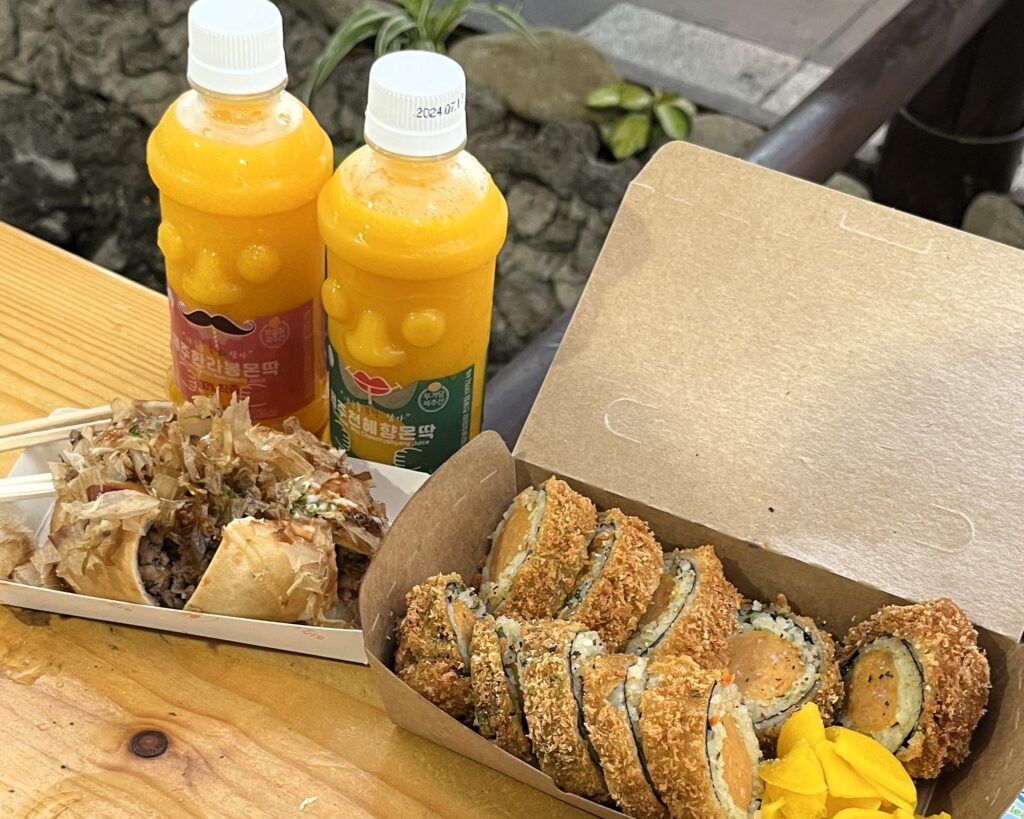
Udo Island Food Specialties
The island is famous for its peanut-shaped rocks on the beach. Locals introduced peanut farms, peanut ice creams, and peanut makgeolli. Peanut’s growing popularity inspires restaurants and cafe menus. A current trendy restaurant is On Off, which serves black pork tonkatsu. I visited this place in 2023 and liked its food and decoration.
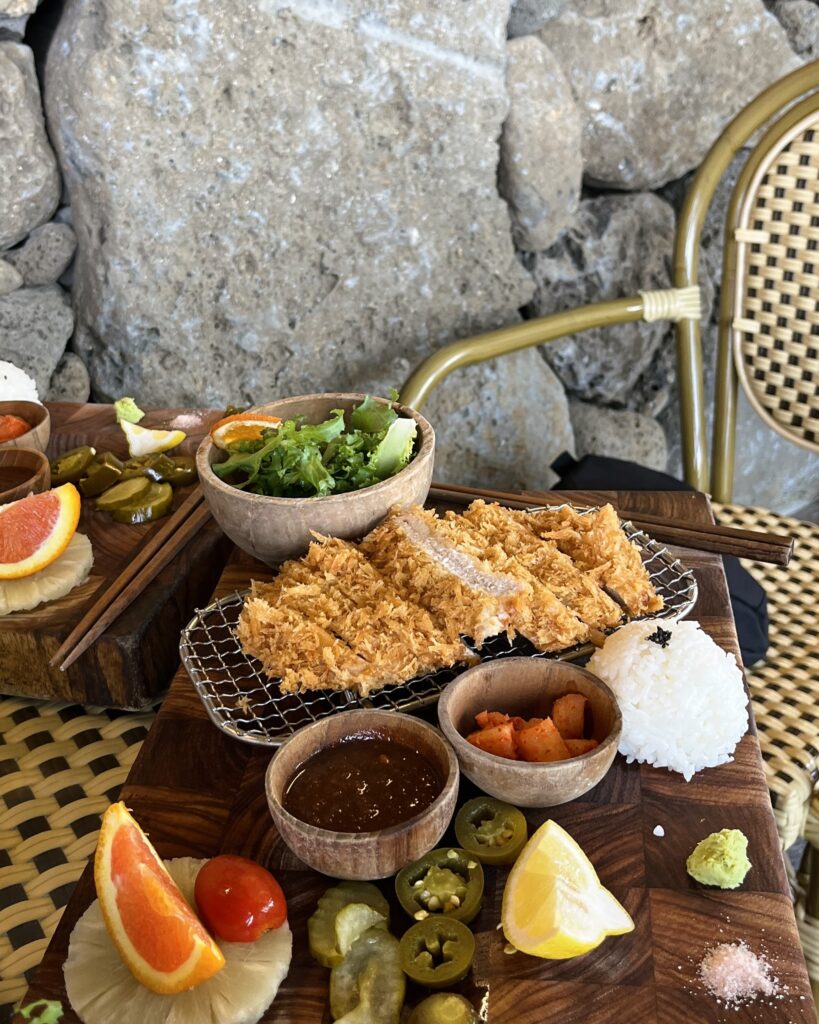
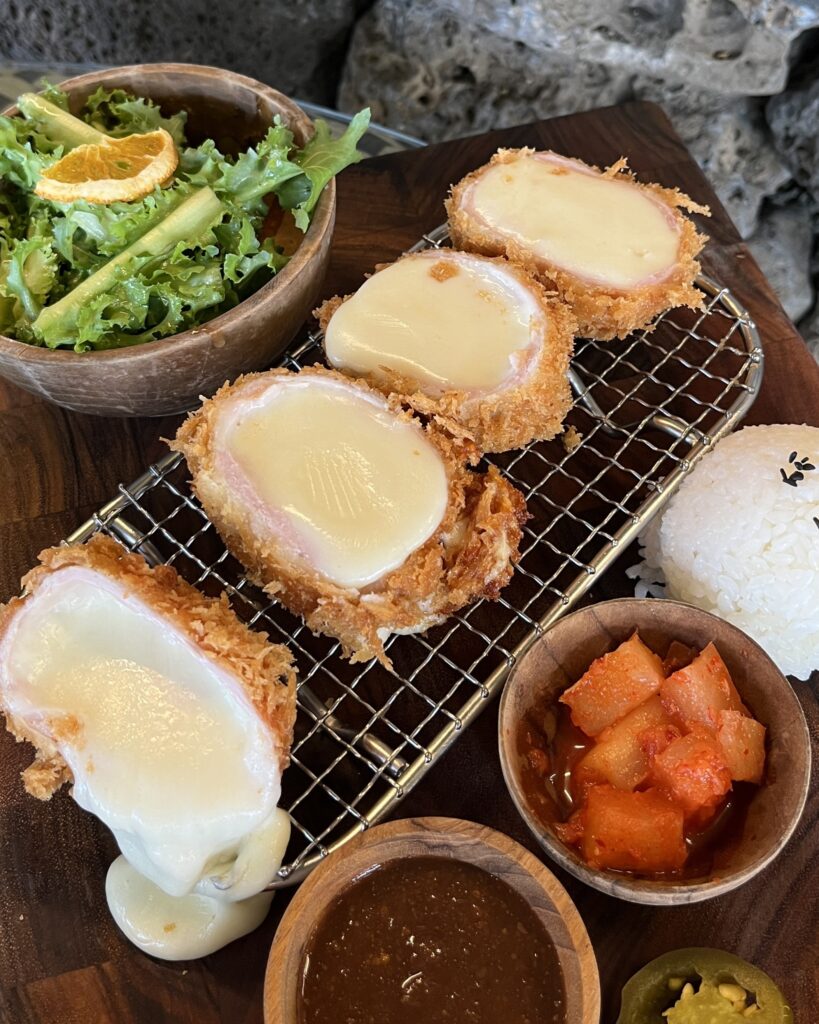
4. Meet The Haenyeo Divers
Jeju culture and history is very unique in South Korea. Being a remote island, an ancient kingdom with its economy and dialect, the fishing culture is different from other sea areas of mainland South Korea. The Haenyeo Divers, also known as Jeju’s Sea Women or Jeju’s Women Divers, represent a deep part of Jeju’s culture and heritage.
Historically, Jeju people, the indigenous habitants of Jeju, lived thanks to fishing. The diving culture started long ago with them, with the development of fishing tools. However, after multiple events and wars, the Jeju people were left poor, with fewer men able to provide. Then, the women trained to become professional divers and be financially stable by selling seafood.

Becoming a Haenyeo is physically demanding. The women were trained at a young age to hold their breath for up to 3 minutes and dive 20 meters deep in the sea. This profession is dying, as the average age of today’s Haenyeos is above 60 years old. Being in our modern era, it is incredible to be able to eat Haenyeo’s seafood.
There are various ways of meeting the Haenyo divers. It is possible to meet and see them at fishing coincidentally while traveling to Jeju. But, to be sure to meet them, head to Seongsan Ilchulbong, where a Haenyeo performance starts every day at 2 p.m. Haenyeo experiences are one of the new activities in Jeju. You dress up like haenyeos and enroll in diving activities. If you don’t feel like being wet, you can also go to the Haenyeo Museum to learn about their history.
5. Beach activities in Jeju
One of the favorite activities in Jeju is spending time at sea bathing resorts. Jeju is an island with unique volcanic areas that are gold for geologists. And the seasides are well-known to be rocky. No wonder the beaches with sand are exceptionally famous while being well maintained with a growing number of shops and facilities.
Locals’ Favorite Beaches in Jeju
Woljeongri Beach 월정리해변 (northeast of Jeju) hosts various events and is one of the nearest beaches to the airport.
Hamdeok Seoubong Beach 함덕 서우봉해변 (north of Jeju) is the nearest beach to the airport.
Gwakji Beach 애월 곽지과물해변 (northwest) is a famous area for sunsets and great cafe spots with sunset views as well.
Jungmun Saekdal Beach 중문 색달 해변 (south of Jeju) is the closest beach to renowned hotels in Jeju, such as the Shilla Hotels.
Hyeopjae Beach 협재해변 (west of Jeju) also hosts various events. The landscape is incredibly gorgeous, with a larger space to swim.
Located in Udo Island: Sanho Beach 산호해변 (with rocks that look like peanuts) & Hagosudong Beach 하고수동해변
Best beaches in Jeju
Swimming culture in Korea
Learning how to swim is not compulsory in Korea. Therefore, not many seaside resorts have authorized swimming. When there is an authorized swimming zone, it is delimited with ropes and guarded. Koreans mostly swim in pools and waterparks. It is also still uncommon to wear revealing swimwear (if not for the gram). Most Koreans wear rashguards and bring inflatable rings and balloons.
Beach activities in Jeju
By the sea, the main activities in Jeju at the beach are sightseeing and swimming. The famous bathing resorts have restaurants, cafes, and good facilities. Watersports and boat tours are gaining popularity, but Jeju is still mainly a relaxing, natural, and family-friendly vacation spot.
Surfing in Jeju
There are some surfing spots in Jeju. The two main spots are Weoljeongri Beach and Jungmun Saekdal Beach. If you are looking for a surfing spot in South Korea, surfers would also recommend going to the East Coast of South Korea. Particularly, Yangyang, Sokcho, and Gangneung.
What sea is around Jeju?
Jeju sits in the middle of 3 different seas: the Yellow Sea (northwest), the East China Sea (south), and the Sea of Japan (northeast).
6. The special tangerines from Jeju
Jeju is home to two particular types of oranges. They are not tangerines, they are not mandarines either, nor they are clementines. Picking up the fruits and eating them are the most-loved activities in Jeju for families. You can find Jeju’s tangerine farms everywhere on the island if you search for “귤농장” on Naver maps or Google maps.
It is a winter fruit, so you might see them green, not yet the appetizing orange color. The trees cultivated inside a glass house have a higher chance of having ripped fruits throughout the year. A famous farm where you can pick up tangerines all year round is 꽃귤농장 (Flower Tangerine Farm). It is located in the south of Jeju Island. The entry costs 18,000 won (15 USD) per person. If you wish to take home some tangerines, it will cost you an additional 10,000 won (7 USD) per kilo.

The places where you can always encounter these fruits are food markets. The average pricing is above 1 USD for one Hallabong (Jeju orange in a gourd shape) and above 8 USD for one kilo of Gyul (Jeju tangerines). It is considered affordable, and Koreans order tangerines from Jeju deliveries in boxes during winter.
How do Jeju oranges taste?
Hallabong (한라봉) is the seedless Jeju orange in a gourd shape. Compared to oranges, they are less sour and taste like grapefruit and orange at the same time. Delicious!
Gyul (귤) is the common seedless tangerine of South Korea. But the ones from Jeju are well-known to be the sweetest and juiciest. It is also very soft, with almost no need to chew. They are Koreans’ favorite winter fruits with strawberries!
7. Flower viewing in Jeju
For those enjoying photography, one of the best activities in Jeju is visiting flower fields. The blooming period attracts many tourists, notably for wedding photography. It makes Jeju Island the favorite picture-worthy destination among couples and Instagram users with perfect feeds.
When to visit Jeju for flower viewing?
-
Visiting Jeju in spring (March, April, May)
Canola in Jeju
The yellow canola flowers are the first blooms of the year. The blooming period is generally around February and lasts throughout spring.
Cherry blossom in Jeju
Cherry blossoms in Jeju start earlier than in mainland South Korea, around the last week of March. The blooms will last 2 weeks. You can see them in parks and streets in Jeju City. The Jeju National University has a famous photo spot walkway.
May Flowers in Jeju
Starting in May, various flowers are blooming such as the cosmos, and tulips. I recommend visiting the Cafe Borowat and Hallim Park in Jeju.
-
Visiting Jeju in the summer (June, July, August)
Hydrangea in Jeju
From June to July, enjoy the beautiful hydrangeas in Jeju. Hydrangeas are tiny flowers blooming into a big fluffy ball. They also bloom in multiple colors, which makes them the perfect flower for pretty themed cafes such as Manor Blanc, Dapdani Suguk Bat, and Cafe Boromwat. Also, the name says otherwise, but Camellia Hill also has hydrangeas!
Summer foliage in Jeju
Sunflowers and tropical flowers can be seen in Hallim Park, glass houses, and at the Cafe Boromwat throughout the summer. Summer is well-known for its greenery rather than its flowers. I recommend visiting the Ossuloc Tea Museum. There are tea fields around the area for tourism.

Visiting Jeju in the fall (September, October, November)
Fall foliage in Jeju
Pink muhly and silver grass are famous in South Korea. They are fuzzy and fluffy like a feather during October and November. The best locations are Hallim Park and Manor Blanc, a cafe with a botanical garden.
Visiting Jeju in winter (December, January, February)
Camellia in Jeju
Starting end of November, the flamboyant red Camellia starts blooming in different locations in Jeju. Jeju Camellia Arboretum and Camellia Hill are the two most-visit locations for camellias. The flowering period lasts until
Winter Foliage in Jeju
Glass Houses also allow you to view different species in one setting all year round. Hallim Park in Jeju has a glass house with various blooms. There are also narcissus and peonies from the end of January to mid-February.
A must-see are Jeju tangerine fields during winter, with cute ornament-like oranges on trees everywhere. Those are not flowers, but extremely cute.


8. Cafe hopping in Jeju
South Korean cafe culture is also present in Jeju! Cafe hopping in Jeju is essential to fully get into vacation mode. There are incredible cafes everywhere. Cafes by the seaside, cafes with sunsets, cafes with botanical gardens, etc. But also, cozy cafe shops, bakeries, and sweets shops.
Since running a cafe business is a competitive market in South Korea, they all have high standards in their drinks, food, and aesthetics. Something to note is the lack of parking places at the cafes near famous beach resorts. Otherwise, it is easy to find a place to park. You can read more about driving in Jeju in the following post: How To Rent A Car in Jeju (Top 8 reasons you need one)

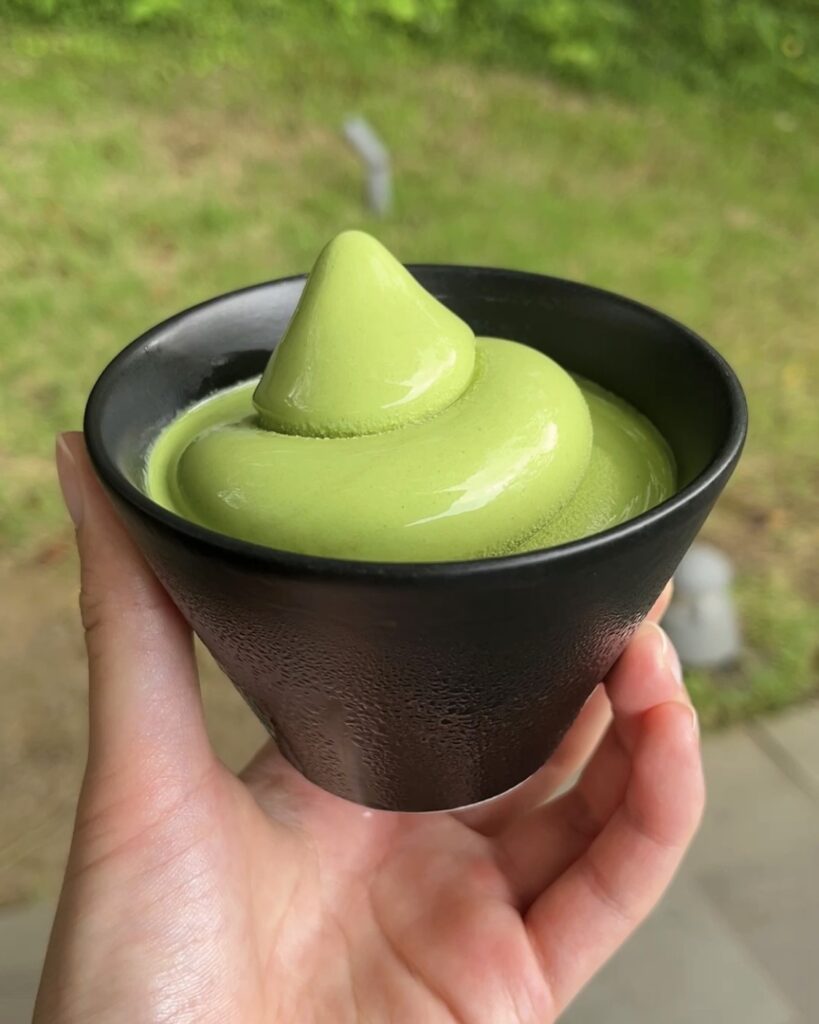
Don’t miss Jeju tangerine desserts and drinks. It is the freshest fruit you could get while in Jeju. At Ossuloc Tea Museum, the cafe menu is all about green tea. Since flowers attract tourists, flower-themed drinks and cakes can also be found on some menus. Enjoy!
9. Honeymoon in Jeju
Did you know that Jeju is also called the Honeymoon Island? Jeju is an island filled with lovely couples for good reasons. Nature is a perfect place after hectic wedding preparations. Many hotels specialize in luxury staycations. And there are many activities in Jeju. You probably have read that in this post!
Watch EuniUnni’s vlog to get more information about what Koreans would do during their honeymoon on Jeju Island. Spoiler, this couple is extremely sweet and loves good food!
Some final words from the writer
Thank you for reading this guide. I hope that it is helpful for your trip preparations to Jeju-do. Traveling to Jeju-do was on my to-do list for a long time, and writing about the island made me realize how much I love this part of South Korea. This guide is completed with more articles about Jeju, take a look here!
About Jeju
In South Korea, Jeju Island possesses the most UNESCO Natural Heritage Sites. It is also a detached island with a unique culture and history, such as the Haenyeo divers, the Jeju dialect, and species only existing in Jeju. This biodiversity makes Jeju the favorite holiday destination among Koreans.
The island is divided in half, with Jeju City in the north and Seogwipo City in the south. At the center of the island is Mount Hallasan, the highest peak in South Korea. Jeju has a humid subtropical climate, but there are four distinctive seasons, each offering beautiful landscapes. There are plenty of activities in Jeju for solo travelers, couples, and families.
Have you found an issue? Is there someone who stole the content of this article? Help us make it right by sending a mail to support@adaysophie.com, thank you!





